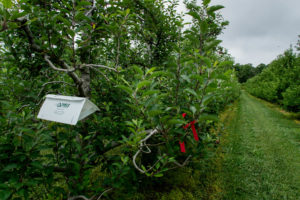WNC Orchard Insect Pest Populations – June 16, 2020
go.ncsu.edu/readext?701501
en Español / em Português
El inglés es el idioma de control de esta página. En la medida en que haya algún conflicto entre la traducción al inglés y la traducción, el inglés prevalece.
Al hacer clic en el enlace de traducción se activa un servicio de traducción gratuito para convertir la página al español. Al igual que con cualquier traducción por Internet, la conversión no es sensible al contexto y puede que no traduzca el texto en su significado original. NC State Extension no garantiza la exactitud del texto traducido. Por favor, tenga en cuenta que algunas aplicaciones y/o servicios pueden no funcionar como se espera cuando se traducen.
Português
Inglês é o idioma de controle desta página. Na medida que haja algum conflito entre o texto original em Inglês e a tradução, o Inglês prevalece.
Ao clicar no link de tradução, um serviço gratuito de tradução será ativado para converter a página para o Português. Como em qualquer tradução pela internet, a conversão não é sensivel ao contexto e pode não ocorrer a tradução para o significado orginal. O serviço de Extensão da Carolina do Norte (NC State Extension) não garante a exatidão do texto traduzido. Por favor, observe que algumas funções ou serviços podem não funcionar como esperado após a tradução.
English
English is the controlling language of this page. To the extent there is any conflict between the English text and the translation, English controls.
Clicking on the translation link activates a free translation service to convert the page to Spanish. As with any Internet translation, the conversion is not context-sensitive and may not translate the text to its original meaning. NC State Extension does not guarantee the accuracy of the translated text. Please note that some applications and/or services may not function as expected when translated.
Collapse ▲ Codling Moth
Codling Moth
Cumulative degree days (DD) for codling moth in Henderson County are about 690 as of today (June 16). This is indicative of about 90% emergence of overwintered adults and 50% egg hatch. While this insect is still a threat to injure apples, populations have been very low in most orchards. Where pheromone trap captures have been high, insecticide applications are still warranted. Off the mountain in Lincoln/Cleveland County, about 1050 DD have accumulated, which indicates that we are between generations.
Tufted Apple Bud Moth
TABM DD accumulations in Henderson County are about 865 from biofix as of June 16. Ideal timing for TABM control is between 800 and 1200 DD, although applications made slightly before this (700-750) often result in good control. If an insecticide effective against TABM has not been made within the past week, one should be made at the next application. In those orchards where codling moth remains a concern, Altacor, Verpedryn or Delegate (whichever AI is being used for first-generation codling moth) will also provide excellent control of TABM. In orchards with low codling moth populations, Intrepid at 6 to 8 oz/acre is a good choice for TABM control. In those orchards using mating disruption for codling moth and OFM, remember that this pheromone does not affect TABM populations, so an insecticide is needed for TABM.
Oriental Fruit Moth
Second generation OFM flight is currently underway, but populations of this generation are typically very low due to insecticides applied at petal fall for the first generation, and overlap of this flight with TABM. Trap captures remained very low at our trapping sites during the past week.
Secondary Pests
Populations of aphids, leafhoppers, and European red mite remain surprisingly low in both commercial orchards and in the non-treated controls of plots at the research station.
Learn more about southeastern apple insect pests at the Apple Insect Management page.
2020 Average Weekly Trap Captures
| HENDERSON COUNTY | |||
| Insects per trap | |||
| Jun 1 | Jun 8 | Jun 15 | |
| Codling moth | 0.5 | 0.4 | 0.3 |
| Oriental fruit moth | 0.4 | 1.1 | 2.6 |
| Tufted apple bud moth | 81.0 | 27.0 | 23.0 |
| Redbanded leafroller | 0.0 | 0.0 | 0.0 |
| Obliquebanded leafroller | 7.0 | 20.0 | 14.0 |
| Lesser appleworm | 7.0 | 8.0 | 0.0 |
| Apple maggot (abandoned and research orchards) | set | 0.0 | 0.0 |
| Brown marmorated stink bug (commercial) | 0.6 | 1.5 | 1.1 |
| Brown marmorated stink bug (unsprayed) | 1.3 | 5.0 | 4.3 |
| Spotted tentiform leafminer | 0.0 | 10.0 | 0.0 |
| Dogwood borer | 37.0 | 58.0 | 36.0 |
| Peachtree borer | 0.0 | 0.0 | 3.0 |
| Lesser peachtree borer | 48.0 | 68.0 | 54.0 |
| San Jose scale | 0.0 | 0.0 | 0.0 |
*Note that these averages illustrate only the timing of insect emergence and fluctuations in populations, and are not representative of population levels in any given orchard. The only way to have an accurate assessment of an individual orchard’s populations is to set up traps in that orchard.
2020 Accumulated Degree Days
| HENDERSON COUNTY | ||||
| Jun 1 | Jun 8 | Jun 15 | ||
| Codling moth (Biofix 4/20) | 402 DD | 541 DD | 678 DD | |
| Oriental fruit moth (Biofix 3/30) | 765 DD | 938 DD | 1111 DD | |
| Tufted apple bud moth (Biofix 4/27) | 507 DD | 680 DD | 853 DD | |
2020 Pest Trends
Visit WNC Orchard Insect Populations for archived posts.


